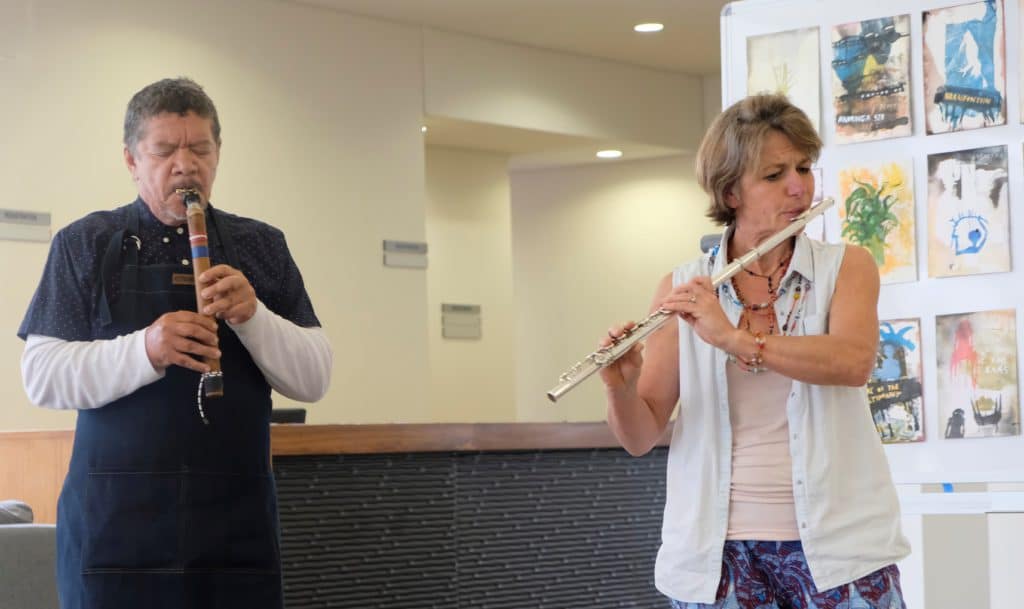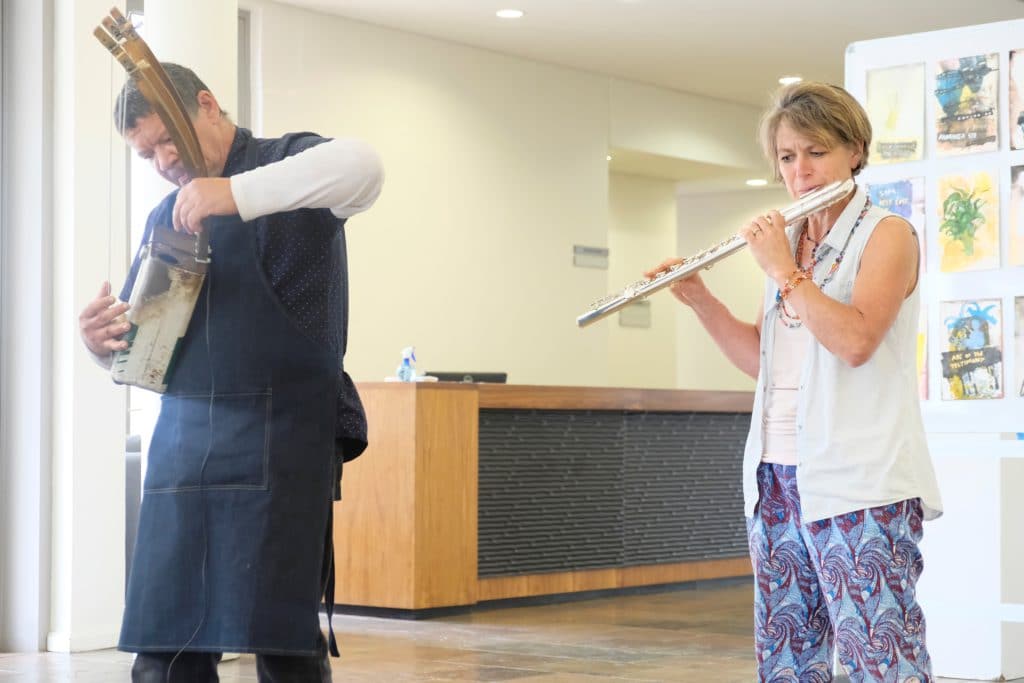“Whilst at STIAS, our project explores aspects of improvisation, in a sense taking on the risk of improvisation itself: spending sonic time, mind ideas, body immersion, together, and waiting to hear what emerges.”
“The core of our investigation will be generative, site-based investigation into our music improvisation, both as practice and as reflexive engagement. The many aspects of improvisation that intrigue us are diverse, and multi-faceted, with the precariousness of sound in flux and in not-knowing perhaps foremost in our music interactions. For our month-long residency, and with a view to developing longer-term artistic research projects, we focus on improvisation as contingent, contextual, mirroring liquid times, and sociality: Improvising as taking risks, but also making a stand; improvisation as acts of risk-taking and stand-making: both the doing and the installation.”
STIAS fellows were immersed in a sensory treat with the first ‘formal’ performance of the improvisation of artists-in-residence Garth Erasmus and Marietjie Pauw of the Africa Open Institute for Music, Research and Innovation at Stellenbosch University.
Garth Erasmus, a Khoi memory-music activist and visual artist who plays on self-constructed instruments that relate to the Khoi mouth bow and ghÔrrah, as well as blik’nsnaar, mcinci flute and pvc bass flute, and Marietjie Pauw, a classically-trained flutist, have collaborated since 2015 bringing together Khoi memory music with Western classical to explore the performance of live music as an agent for important discourses around topics such as inclusion-exclusion; place and history; and harm and healing.
“The work can perhaps be described as a sonic form of decolonial aesthesis, and an enactment of interventionist curating amidst publics, institutions, art and music-making,” said Pauw.
Their first collaboration in 2015 combined composed-scored music with free improvisation to engage with the erased history of forced evictions from ‘Roesdorp’ (the colloquial term for an area along the Eerste River in Stellenbosch). Subsequent collaborations included ‘Khoi’npsalms’ (2018) which used Genevan (Calvinist) psalm melodies as source material for improvisation, as a critical engagement with colonial histories; a collaboration on the history of the Pieter Okkers-huis in Stellenbosch (2018) and a series of short films made by filmmaker Aryan Kaganof.
This year during the COVID-19 lockdown they worked on a five-week project using mobile phones to capture 24 short sound improvisations, subsequently exhibited internationally by the ‘Radical Acts of Care’ exhibition under the curatorship of Greg de Cuir Jnr. (available at https://mediacityfilmfestival.com/dark-dark-gallery/). Since March 2020 they have also built collectives of improvisers with other musicians such as Pierre-Henri Wicomb, Visser Liebenberg, Cara Stacey and Neo Muyanga, to form Africa Open Improvisation. This collective produces longer pieces of free improvisation on instruments and prepared instruments and human bodies. The process of steering through the limitations of online technology spurred them to register a research project with the Stellenbosch University Faculty of Arts and Social Sciences, and also open an online site where their music is archived publically (available at: https://soundcloud.com/user-610733588).
In addition to the auditory feast, Erasmus also displayed artworks completed during his time at STIAS. He explained that these are inspired by the music and have allowed him to experiment in a new medium, using paper stencils which become wet during printing and thus “the shape disintegrates, becomes out of control, unintentional and surprising, which adds new meaning to the images”.
“I’ve been wanting to do this for a long time,” he added, indicating that some of the stories are the result of gigs in the hinterland since 1999 with his group Khoi Khonnexion.
“These areas have a storytelling tradition that you don’t find in the urban environment,” he said. “I’m resurrecting stories I hear and find which come out in the vernacular, in a non-academic way and are sometimes completely forgotten about in South African history.”
Pauw explained that using their music they aim to move between different worlds “to create something new out of an often awful history”.
“It’s not just fun, but also risk – reflecting past stories, our individual and group histories and experiences, shaped by geo-political place and historical time, and current activisms.” She pointed to the experience of making music under lockdown as “amazingly freeing, not all being stuck in one place but making music together” but also a reflection of the uncertainty of the current global experience.
“But,” added Erasmus, “you cannot fully replace human contact by online. I believe humans charge the air, trigger a connection and this changes what happens. It’s a spiritual, out-of-body experience when you get it right.”
Not just anything goes
They also spoke more broadly about the technical and personal challenges of improvisation.
“Initially I was playing every note (from notated scores) while Garth improvised around me,” laughed Pauw. “I’m still very young at improv and have a lot to learn. Building a structure without knowing what the other person is going to do next is fun. It’s a radical act of care and vulnerability, a connection between mind and body. You use all your senses.”
“Improv is a very difficult thing to do,” explained Erasmus. “You can’t legislate for the emotions others bring to the process. Making it work is interesting. People think anything goes in improv but, if anything goes, nothing matters. You bring your attention, technical skills, cleverness, ideas. Playing is like a conversation and sometimes if you force attention, it falls apart. You compromise for one another – give and take. We don’t always know what we are doing but we do it.”
But he also pointed out that the great musicians didn’t just spontaneously compose their masterpieces – “they played around, tried things, then captured it”.
“You work in the mistakes,” added Pauw. “Allow things to emerge.”
“It will be interesting to see how people react,” said Erasmus.
Michelle Galloway: Part-time media officer at STIAS
Photograph: Noloyiso Mtembu


